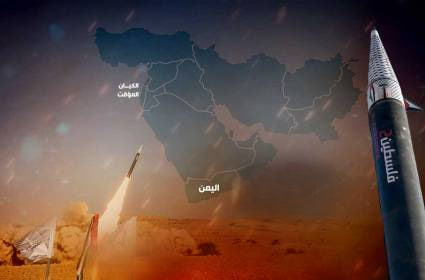Yemeni Hypersonic Missiles: A Nightmare Shaking the Zionist Entity
Amid the rubble of conventional military calculations and deterrence doctrines, Yemen’s hypersonic missiles have emerged as a game-changer—demonstrating that in today’s world, power is no longer the exclusive domain of global superpowers. Under blockade and aggression, Yemen has proven not only its ability to retaliate, but also its capacity to fundamentally transform the strategic balance in its confrontation with the Zionist entity.
With God’s help, the Yemeni Armed Forces have succeeded in deploying this advanced deterrent weapon on the battlefield. These missiles, with their real and direct impact, have ushered in a new era of field deterrence—one where enemy propaganda and “iron umbrellas” are rendered ineffective.
Shock in Tel Aviv: The Beginning of Collapse
Yemeni missile strikes deep inside occupied territory have been among the most disorienting developments for the enemy. The Zionist entity had not anticipated that its strategic depth would be targeted by ballistic and hypersonic missiles launched from Yemen, penetrating its skies without being detected or intercepted by its layered defense systems.
The greater shock came from the fact that these missiles outperformed both American and Israeli defense systems, including:
-
Arrow 2 and 3
-
David’s Sling
-
U.S. THAAD, SM-3, and SM-6
These systems, long touted as untouchable shields, proved utterly incapable against Yemeni missiles traveling at speeds exceeding Mach 13, maneuvering beyond radar tracking and interception capabilities.
The Collapse of the “Iron Dome” Doctrine
This defensive failure is no mere glitch; it represents the collapse of Israel’s entire deterrence doctrine. For the first time, the enemy finds itself exposed, unable to protect its civilian or military depth—forcing a complete reassessment of its defense systems and combat strategies.
Decision-making circles in Tel Aviv are now compelled to rebuild strategies from scratch, recognizing that air superiority and interception supremacy are no longer guaranteed—particularly in the face of a Yemeni weapon that cannot be easily intercepted nor predicted.
A Belated Response… Without Guarantees
In an attempt to patch its failures, Israel’s Ministry of Defense announced work on developing the Arrow 4 system and upgrading radar and sensor technologies with U.S. collaboration. Yet these efforts come with no operational guarantees, especially given the dynamic complexity of hypersonic missiles.
Engaging a missile capable of maneuvering, re-entering the atmosphere, and striking at speeds up to Mach 15 is nearly impossible—even with the world’s most advanced technology.
The End of Israeli Deterrence
Military expert Brig. Gen. Mujeeb Shamsan confirmed that continued Yemeni strikes place the Zionist entity in a permanently shaken defensive posture. Targeting Yemeni infrastructure—such as the ports of Hodeidah and Ras Issa or fuel stations—does not alter the reality: Israel seeks to project an illusion of control to its domestic audience, while in truth it is Yemen that dictates the battlefield equation.
He emphasized that Yemeni forces operate with strategic precision, carrying out sustained operations since October 18, 2023, that will not stop until the aggression ends and the siege on Gaza is lifted.
The Collapse of Israel’s Media Narrative
Shamsan also noted that Israel is failing to sell a convincing media narrative to its own public. Claims of “successful interceptions” or attributing explosions to “electrical faults” or even “meteors” no longer fool anyone.
It is now evident that most Yemeni strikes have hit critical targets. If Israel could intercept them outside its territory, it would have done so immediately. Instead, the constant footage of explosions inside occupied cities is little more than a desperate attempt to mask panic and dress up failure for the settlers.
Yemen Imposes an Aerial and Naval Deterrence Equation
Yemen has not only enforced a land-based deterrence, but also shifted the battle to the skies and the seas—reshaping U.S. and Israeli calculations. Shamsan stated that Yemen, often portrayed as a “developing state,” now possesses stealth-aircraft detection technologies and naval missiles that have redefined rules of engagement.
Even the vast U.S. arsenal in the Red Sea has failed to curb Yemen’s capabilities or halt its strikes—leaving the Zionist entity to bear the full consequences of the aggression, absent any meaningful American protection.
A State of Panic and Paralysis
Brig. Gen. Nidal Zahwi described the devastating psychological impact of Yemeni missiles on Israeli society, noting that settlers now live under the constant sound of sirens and the confinement of shelters, while tourism and the economy suffer paralysis.
Each Yemeni missile, he explained, brings entire cities to a standstill—reviving dangerous questions about the future of the Zionist entity, the resilience of its home front, and the credibility of leaders who hide the truth and fear reality.
A New Dawn for Yemen… and the Sunset of Israeli Deterrence
Yemen’s hypersonic missiles are no longer theoretical weapons of deterrence but a tangible reality reshaping the battlefield. The enemy now faces an unprecedented dilemma: it cannot predict, intercept, or contain these strikes.
What the Yemeni Armed Forces achieve today goes beyond tactics—it strikes at the very heart of Israel’s defense doctrine. Talk of developing new defenses is nothing more than a desperate attempt to patch an irreparable collapse. As the war on Gaza continues, Yemen’s support operations intensify—affirming with each strike that Yemen is not merely present in the battle, but leading it.

